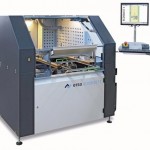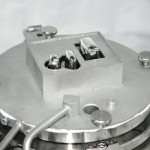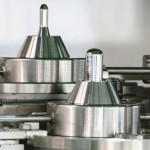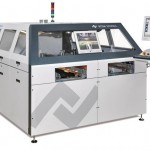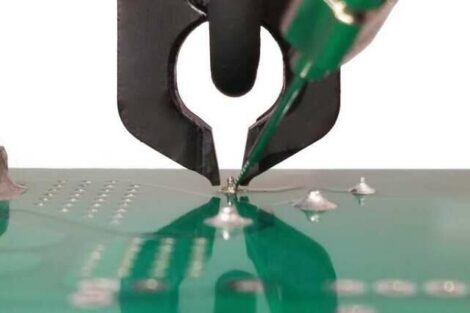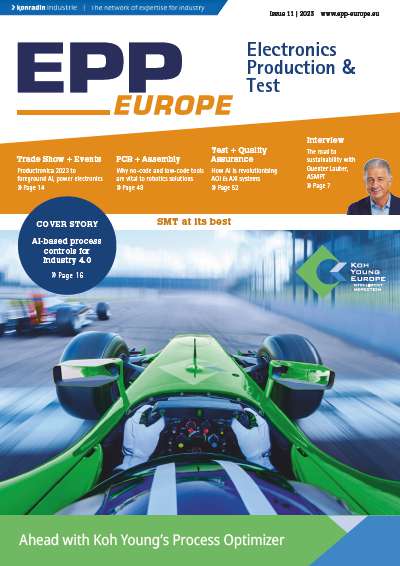For quite a few years now, a reorientation in the manufacture of electronics assemblies can be observed. Classical production lines are more and more being replaced by small flexible islands. The causes are manifold: products and services are becoming more individualized, time-to-market and the product life cycles have shortened and the global competition has dramatically increased. In order to react quickly to these changing demands, a move to a more flexible shop floor has become unavoidable. Therefore, flexible and easily re-configurable manufacturing islands are, in ever increasing numbers, replacing the dedicated line-up of different systems found in expensive, highly automated lines.
Jürgen Friedrich, Ersa GmbH, Wertheim, Germany
A dominating market segment in European electronic production is taken up by industrial electronics. Yet, even in this segment a restructuring has and is still taking place, away from standard products towards customer specific solutions. The focus on products manufactured in high volumes has therefore, during the last few years, changed to one of a close orientation towards the customers. For the manufacture of electronics, this meant that mass production of standard goods had to give way to an individual, demand oriented just-in-time production of a customer’s specific needs and products. Manufacturing strategies for these two concepts are of two completely different worlds, and their demands are actually contrary to each other.
Mass production is characterized by permanently installed, dedicated production lines, where retooling and setup for a change-over can be time consuming and costly. They also require large initial investments and have to be operating at full capacity, if they are to be economical. In such dedicated lines, the notion of flexibility is only marginally present, leading inevitably to high levels of work-in-process and to long cycle times for completion of the product. Increasing the flexibility is only possible through breaking up the dedicated line of systems. The solution lies in flexible, decentralized production islands which can quickly and individually be adapted to correspond to different capacity requirements.
The flexible manufacture in those islands brings to light further interesting economic aspects. For example, in the production island the insertion of through-hole components can be combined with the assembly of the PCB. This way, the material flow is minimized, binding less capital since smaller numbers of inventory is on the floor. Costly interim storage of semi-finished products can be substantially reduced.
One step in production that is frequently integrated into production islands is the process of selective soldering of through-hole components. After inserting and soldering the components follow visual/optical and electrical verification measures (depending on individual requirements) of the board assembly, the mounting of the assembly into its housing, closing the unit and a final functional test of the finished module.
On account of the potentially large number of tasks that can be performed in a production island, short cycle times for the selective soldering process are usually not required. This fact has many positive consequences for the selective soldering system. Since sufficient time for the soldering process is available, fluxing, preheating and soldering can be run sequentially, which allows to substantially reduce the overall size of the system and therefore the floor space required by it.
These requirements are rigorously implemented in the Ersa selective soldering systems Ecoselect 1 and Ecoselect 2. To realize its small foot print, these systems are equipped with a single X-Y-Z axis. Both, the solder unit as well as the multi-drop fluxing system, are mounted on this axis.
Sequence of process steps and the system structure
In both systems, the board assembly being processed is clamped in position for the entire process. The axis system covers the full working area below the assembly, ensuring fluxing and soldering. After the fluxing process is completed, the axis holding the tools moves aside to make place for the preheat cassette which is moved, pneumatically on linear guides, underneath the assembly. Once preheating is completed, the cassette is again moved aside and the area underneath the board is released for the soldering process.
In the Ecoselect 1, entering the assembly into the processing position is performed manually. Through a drawer-type system, the board carrier is manually placed in the system, and processing of the assembly starts automatically when the safety door is closed. In the Ecoselect 2, the assembly respectively the board carrier moves automatically on a conveyor into position, where it is clamped down for the full process cycle. The exit of the assembly from the system can be selected to be either at the in feed position or in-line to an external conveyor.
All process modules such as fluxer, preheater and solder bath originate from the proven Ersa Versaflow family. Holding an inventory of wear parts is thus greatly reduced, and the users‘ acceptance is virtually assured, as the parameters and the system set-up is directly comparable to the other Ersa selective soldering systems.
Precise and flexible fluxer
Installed in the fluxer unit are multi-drop flux heads, which deposit the flux precisely and in reproducible volume to the board. Flux residue on the PCB after soldering is thus reduced or altogether eliminated. This can only be achieved by not vaporizing the flux, as is usually done, but by generating extremely small droplets, which are aimed directly onto the joint to be soldered, a technology comparable to the inkjet printing technology. The application of this technology is forced on to the industry by, amongst other reasons, technological changes in the area of board assemblies. Metallization on boards used for keyboard applications, solder-free contacts for displays, or sealed and glued areas may under no circumstances be contaminated by flux residue or flux spatter.
In the automatic operation of the soldering system, the full fluxing process is continuously monitored. This automated monitoring encompasses the position of the spray, which is assessed by a laser light barrier. If the spraying position deviates more than a certain tolerance value from the nominal value, the process is stopped and a message identifying the problem is being issued for the operator.
The motion and the process steps of the fluxer are stored in the soldering program. Optionally, two flux heads working with different fluxes can be installed, so that for alternate operations two different fluxes are available on-the-fly for use at the system.
Very effective preheating
The process step of preheating board assemblies is of great importance for the lead-free soldering process. The heat balance of a solder joint when using SnCu and SnAgCu formulations depends largely on the preheating temperature, particularly so when the assembly itself possesses a high heat capacity. Above mentioned solders solidify quicker, since the heat surplus over the melting point, when compared to SnPb solder, is smaller. Yet, just this physical disadvantage of the solder materials can be compensated for by an effective preheating system.
As a general rule for all Ersa selective soldering systems, preheating systems with short-wave IR emitters and hybrid-convection preheaters are available. To preheat the solder side of an assembly, IR emitters are being used below the conveyor, while the optional hybrid-convection top-side preheater is installed over the assemblies. Since the top-side preheater in the Ecoselect 1 and 2 is installed over the process area of the board, it can be used during the preheating cycle as well as during the soldering cycle.
The use of the top-side preheater during the soldering process ensures that the optimal process temperature is maintained throughout the soldering cycle, preventing a cooling off of the assembly during an extended solder cycle.
Mini-wave solder unit – multiple possibilities
The flexible mini-wave solder units are mounted on an X-Y-Z system, they are therefore very flexible in their freely programmable motion sequence. The units work with small mini-waves, which feature a wettable surface. In lieu of a mini-wave, a small dip solder nozzle plate could be installed. This product-specific designed tool solders all joints of an assembly in one cycle. The cycle time of the soldering process can thus be reduced to a few seconds.
Even more helpful add-ons are available for the solder modules: the option Z-Variable offers two solder bath which can be pneumatically raised to processing height or, alternatively, lowered to a stand-by position, depending on which solder bath is to be activated and brought into process. The user can thus either work with two different sized nozzles on the system or with two different solder alloys. Activation of the required solder bath is through the solder program.
In addition to the Z-Variable, the solder modules are also available with the option Y-Variable. Here, the distance between the two nozzles, each mounted in its own bath, can be mechanically adjusted within a defined dimension, whereby both nozzles are adjusted to the process height. This allows that two identical assemblies – useful in situations where multiple-ups are being processed – can be soldered simultaneously, thus reducing total cycle time.
On account of Ersa’s long standing experience and its continuous drive to further the development of their solder baths, the company is in the position to ensure all of its customers entirely safe and fully monitored processes. A lot of parameters and functions are continuously controlled: solder level monitoring in connection with the automated solder wire feeder, monitoring of nitrogen for the protective atmosphere around the solder waves, the temperature of the solder, the height of the solder wave, etc.
Maintenance requirements are reduced to a minimum, as the small solder bath contains only small amounts of solder and is equipped with an electromagnetic pump. These solder pumps are absolutely maintenance free, since they contain no moving parts such as motors, bearings, impellers, drive belts, etc.
The solder process itself is supported by the permanently flowing solder. Through the heat stored in the liquid solder as it leaves the nozzle, there is a continuous heat transfer at the location where the joint is to be formed. This is of particular interest when lead-free solders are used, as the solder temperature in the bath can then be set at a lower temperature.
Super-sizing the island
Some manufacturers have transferred the successful strategy of small flexible production islands to include larger systems. Since higher throughput is demanded by the customers, selective soldering systems – designed for operation as production islands – which were capable of simultaneously processing more than one board assembly were called for. Fluxing, preheating and soldering have to take place again in parallel, the same process sequence as in the standard, large selective soldering systems.
Initially, this demand clashed with the requirement that the systems be compact, that they have a small footprint. After all, one the largest benefit of the production island is the fact that one person can perform a number of tasks while the selective soldering system is processing a board, and all that without having to move very far.
The Ersa Ecocell provides an appropriate answer to this issue, featuring an in-line system with U-shaped conveyor system. The system is designed so that the in-feed and exit positions of the boards lie side by side. Loading and unloading the boards by the operator is done from the same position, thereby providing short ways. The system concept features 5 individual work stations, which can be configured as 1 x fluxing, 2 x preheating, 1 x dip soldering and 1 x mini-wave soldering. With this configuration, it is possible to achieve cycle times of below 30s per board or board carrier. Retooling one of the solder bath can be done on-the-fly, without having to interrupt production.
An outlook
Flexible production islands are the answer to the permanently changing demands of the markets and the increasing product diversification. Manufacturing in such an island simplifies the task of adjusting capacities to actual needs, when compared to dedicated production lines. This capacity adjustment minimizes the amount of work in process, and reduces the flow of materials through limiting the movement of parts and components. Less capital is bound, and pass-through times are shortened.
The Ersa selective soldering systems Ecoselect 1 and 2 as well as the Ecocell are ideally suitable for use in production islands. These systems are easy to use and highly economical, as operating costs are low, and the availability of the system is very high. Their networking capabilities allow off-line programming and the integration of traceability architectures, and remote maintenance is another standard feature. These small and compact selective soldering systems stand tall, and each offers high quality in design, function and performance.
Productronica, Booth A4.161, 171 and B2.225
Zusammenfassung
Hohe Flexibilität in der Elektronikfertigung und gleichzeitig niedrige Kosten erreicht man durch sogenannte Produktionsinseln, in die solche Aufgaben ausgelagert werden, die sich im hochvolumigen Inline-Prozess nicht optimal ausführen lassen. Ein typischer Insel-Job ist Selektivlöten. Ersa hat dafür Lösungen entwickelt, die kompakten Footprint, cleveres System-Design mit vielen hilfreichen Funktionen und Optionen sowie niedrige Betriebskosten vorteilhaft miteinander verbinden.
On obtient une grande flexibilité dans la fabrication électronique et en même temps des coûts faibles par ce que l’on a coutume d’appeler des ilots de production dans lesquels ont transfère des tâches qui ne peuvent pas être réalisées de manière optimale dans des processus Inline de grande ampleur. Un travail typique en ilot est constitué par la soudure sélective. Pour cela Ersa a développé des solutions qui associent avantageusement le Footprint compact, un design de système astucieux avec de nombreuses fonctions et options utiles et avec des coûts d’exploitation réduits.
Share:


